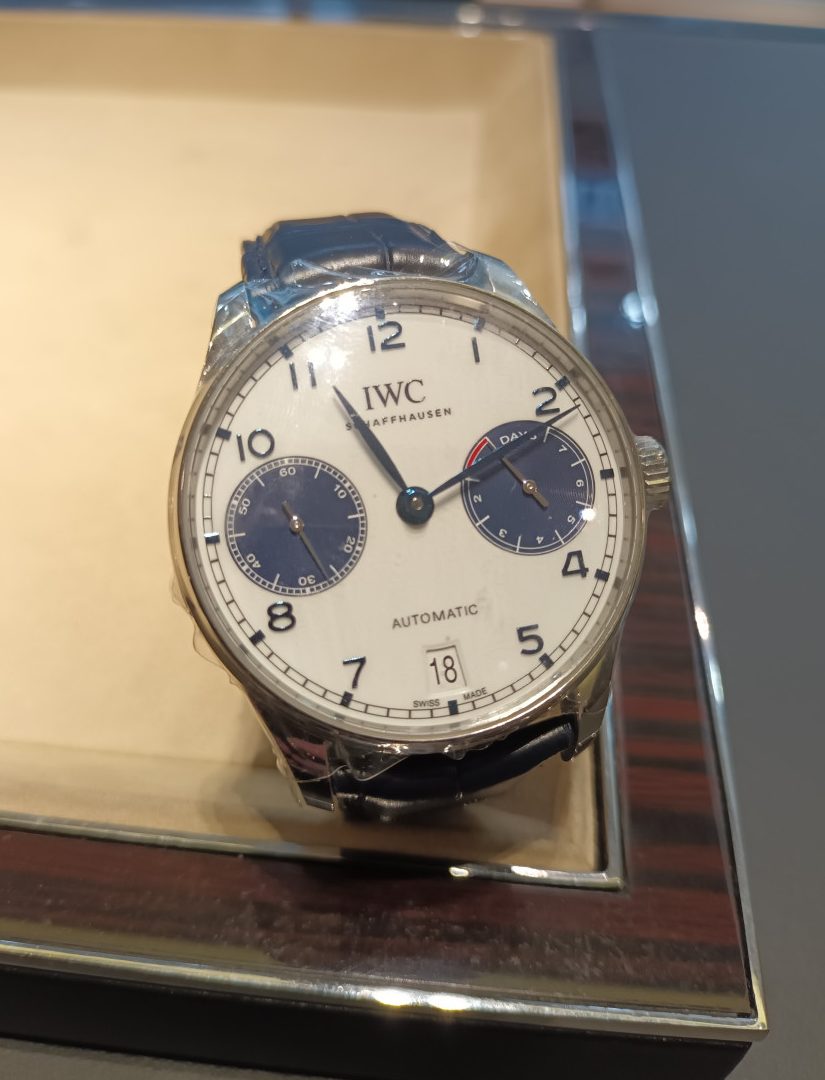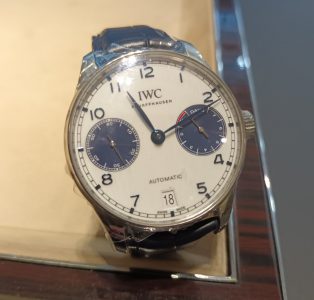I confess to being an IWC fan – at least on the pilot watch side. I currently own three such models, covering some 4, 10 and 15 years, and to-date, they continue to perform exceptionally well! However, their other watch designs have not particularly grabbed my attention – probably down to a lack of effort on my part to explore as much as anything. All that said, a recent trip to a friendly retailer source may have shifted this deficiency, when I was presented with a current Portugieser model to view and hold.
At this point I usually drone on about the history of a brand. I shall do so here, but it will be very minimalist, as frankly one can just go to IWC’s own website and get all the data there! Anyway, the bones are that The International Watch Company (IWC) commenced in 1868 in Shaffhausen in Switzerland. Unusually, it was started by a Boston watchmaker called Florentine Aristo Jones. He was enthused by modern production methods in the US – mainly in the gun manufacturing line, and so went to see if he could inbuild this into Swiss watchmaking. He ended up in Shaffhausen and did indeed start a business there. It was initially a success – particularly with pocket watches and their movements, but alas financial problems ensued. The result was that IWC was acquired by the Rauschenback family in 1880, and they owned the business for many years. In 2000 the business was acquired by the Swiss luxury conglomerate Richemont. Today, IWC is a major watch brand mainly focusing on higher end models covering most genres.

So, to the model in question here – reference IW500715. This came out last year and is a 42.3mm (14.1mm tall) stainless steel cased automatic watch, with a white dial and two blue sub-dials. It therefore attains the nomenclature of being a “panda” dial.
The case itself is round, but emphasized more so due to the quite modest lugs. Both brushing to the sides and high polish atop is at hand. The bezel is minimal and therefore accentuates the dial proportions more. There is a decent sized conventional looking crown, so plenty of grip is afforded when required. Underneath reveals a very large exhibition case which nicely exposes the inner workings. Water resistance is noted at 30m. Sapphire crystal is used fore and aft, with anti-reflection properties.

With this model the dial is white and lacquered, with no decoration/engraving. Outboard is a minute rail track, then Arabic numerals – shiny and raised in a deep blue – Navy I feel. Three of these are sacrificed at 3, 6 and 9. The first and last in order to accommodate two registers – the power reserve gauge (showing up to 7 days), and a small seconds respectively. These are in Navy too (with white graduations) – the power one also popping a red flash to warn when only one hour of energy remains. The other is for the date window – the number(s) appearing black to me. Regarding hands, the main two are long-leafed (feuille) in shape and are blued. The sub-register ones are more sword-like in a stainless polished finish. Finally, the words IWC Shaffhausen under 12, and Automatic above 6, seem also to be in black. I see no luminescence at all here.

Turning the watch over, one can view the in-house made caliber 52010. This came on-line in 2015, and by all accounts is a very good power source, boasting two barrels that can accumulate up to 168 hours (7 days) of running time. The beat is 28,800 and smoothed by 31 jewels and 257 components. In common with IWC (as they invented it), there is a bi-directional Pellaton pawl-winding system, along with a Breguet spring. Additionally, the use of ceramics (black and white), in the winding wheel and rotor bearings ensure a reduction of potential wear from the norm. There is some nice decoration – mainly in the form of Cotes de Geneve and perlage. The rotor is substantial (as one would expect with two barrels to power), but is skeletonized and has the gold IWC Probus Scarfusia (from the Latin – loosely meaning “good craftsmanship”) medallion inset.
Lastly, the watch benefits from a top-quality alligator strap – in this case dark blue – but black and brown options are also available. A deployant-type mechanism is utilized, with a stainless steel buckle and logo finishing everything off.

There are a number of variant looks in this precise range – via mainly different dial colour combinations (e.g. silver, blue, and maroon), and also some gold cased versions. The stainless steel ones are priced at £11,100, with the gold options rising to a over £16,000. The overall range does include some more affordable stainless steel models – down at the £5-6,000 level. Chronographs, perpetual calendars – and even tourbillons are available – the latter two in gold. Extremely deep pockets are needed for these!
Conclusions? Well, clearly, this is a very well made watch from one of the top Swiss brands. It boasts a high quality in-house movement with some quite modern innovations to aid accuracy and longevity. Although it is not chronometer rated, one should still expect a high degree of accuracy. In fact IWC have regulated the movement to -7 to +7 seconds per day, but some owners report even better at -3 to + 3 seconds – so actually within chronometer levels! The overall aesthetics of the case and dial are excellent – with the relative simplicity of each providing all information in a clear and concise fashion. Out of all the dial options, I personally favor this white/blue dial piece. Any niggles? Well, I would have liked some lume to aid night time viewing. Some may also find the watch a bit large/chunky (my average male wrist accommodated it just fine. Ed) – but those are really small blips. Value for money? That, of course, is a very subjective question. By most standards, paying over £10,000 for a watch is a big deal – especially when there is little or no precious metal involved. That said, for most people this will be a special and long-term purchase, and when you consider all aspects, I do feel it is a pretty equitable proposition overall. Oh, I nearly forget, in addition to the standard two year warranty, there is the online option to extend to eight years free (something I have done. Ed), so the brand is clearly happy to quality underwrite it’s products!
Rating: 4.5/5
Words: The Writer. Images: The Writer & IWC.
My thanks to Berrys in York for allowing access to the watch.


